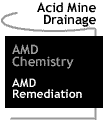
Water
Pollution: Acid Mine Drainage: Chemistry
Groundwater often
flows through the cracks in the crushed sulfides, or sulfur-rich minerals,
that remain after an area has been mined. One of the most important sulfides
found in the waste rock of mines is iron sulfide or pyrite (FeS2). This
sulfide is more commonly known as "fool's gold." When pyrite
is exposed to water and oxygen, it undergoes the following oxidation and
reduction reactions to form acid mine drainage (AMD):
2FeS2 + 7O2 + 2H2O
2FeSO4 + 2H2SO4 (1);
2Fe2+ + 1/2 O2 + 2H+
2Fe3+ + H2O (2);
Fe3+ + 3H2O
Fe(OH)3 + 3H+ (3).
The net equation for this set of reactions is:
FeS2 (s) + 15/4 O2+ 7/2 H2O
4H+ + 2SO4- + Fe(OH)3 (s) (4).
Equation 1 depicts the oxidation of inorganic sulfur to sulfate and the subsequent production of sulfuric acid. The next step shows how ferrous iron is oxidized to form ferric iron and water. When drainage containing these pollutants reaches the stream, it becomes diluted and the pH of the solution rises. The increase in pH allows ferric hydroxide (Fe(OH)3; A.K.A. "yellow-boy") to precipitate out. This chemical reaction is illustrated in equation 3. As indicated in equation 4, a net of four moles of hydrogen ions (H+) are liberated for each mole of pyrite (FeS2) oxidized, making this one of the most acidic weathering reactions known.
Acid mine drainage depletes the buffering capacity of water by neutralizing carbonate and bicarbonate ions to form carbonic acid (H2CO3):
H+ + CO32-
HCO3-, then
H+ + HCO3-
H2CO3.
Once exposed to AMD, the affected carbonate buffering system is not able to control changes in pH as well. The buffering system of the stream is completely destroyed below a pH of 4.2, where all carbonate and bicarbonate ions are converted to carbonic acid. Carbonic acid (H2CO3) readily breaks down into water and carbon dioxide:
H2CO3
H2O + CO2.
Overview ..|.. Acid Mine Drainage ..|.. Agriculture ..|.. Sewage ..|.. Dredging
AMD Chemistry / AMD Remediation
Glossary .|. Related Links .|.. References ..|.. PBL Model.Home ..|.. Teacher Pages ..|.. Modules & Activities
HTML code by Chris Kreger
Maintained by ETE Team
Last updated November 10, 2004
Some images © 2004 www.clipart.com
Privacy Statement and Copyright © 1997-2004 by Wheeling Jesuit University/NASA-supported Classroom of the Future. All rights reserved.
Center for Educational Technologies, Circuit Board/Apple graphic logo, and COTF Classroom of the Future logo are registered trademarks of Wheeling Jesuit University.
